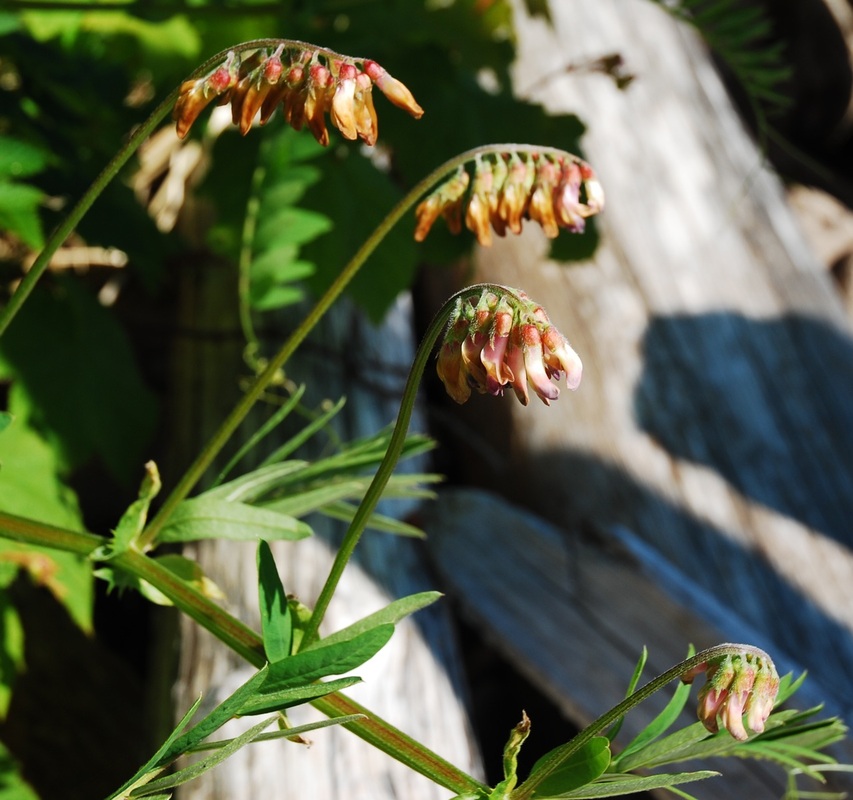Giant vetch, black vetch • Vicia nigricans ssp. gigantea, Vicia gigantea
Identification
Giant vetch is a perennial species with climbing or ascending stems that reach 2 m long. The stems are thick and hollow. The leaves are compound, with 18-26 elongated, pointy-tipped leaflets to 3.5 cm long. The end of each leaf has a branched, somewhat curling tendril. The flowers are pea-like and range in colour from yellow-white to orange or reddish-purple. A clusters of 7-20 flowers attach to one side of a stalk. Giant vetch produces hairless fruit pods.
Habitat & Range
Giant vetch grows at low elevations in disturbed locations such as the edges of beaches, streams, forests, meadows, and in clearings. It is found in coastal areas from Alaska to California.
Similar Species
Other vetch species are found along the central BC coast, including American vetch (Vicia americana) and tufted vetch (Vicia cracca). Neither species has yellow or orange flowers, and both are smaller. The hollow stems of giant vetch are also distinctive.
Human Uses
Giant vetch is traditionally used as a cover for steaming sprouts (Makah First Nation) and in the production of hair tonic (Saanich First Nation).
Giant vetch is a perennial species with climbing or ascending stems that reach 2 m long. The stems are thick and hollow. The leaves are compound, with 18-26 elongated, pointy-tipped leaflets to 3.5 cm long. The end of each leaf has a branched, somewhat curling tendril. The flowers are pea-like and range in colour from yellow-white to orange or reddish-purple. A clusters of 7-20 flowers attach to one side of a stalk. Giant vetch produces hairless fruit pods.
Habitat & Range
Giant vetch grows at low elevations in disturbed locations such as the edges of beaches, streams, forests, meadows, and in clearings. It is found in coastal areas from Alaska to California.
Similar Species
Other vetch species are found along the central BC coast, including American vetch (Vicia americana) and tufted vetch (Vicia cracca). Neither species has yellow or orange flowers, and both are smaller. The hollow stems of giant vetch are also distinctive.
Human Uses
Giant vetch is traditionally used as a cover for steaming sprouts (Makah First Nation) and in the production of hair tonic (Saanich First Nation).
References
Pojar, J. and MacKinnon, A. (1994). Plants of Coastal British Columbia. Vancouver, BC: Lone Pine Publishing. P. 193.
Vicia nigricans Hook. & Arn. In Klinkenberg, Brian. (Ed.). E-Flora BC: Electronic Atlas of the Plants of British Columbia. Lab for Advanced Spatial Analysis, Department of Geography, University of British Columbia, Vancouver. Accessed 10/04/2014.
Authors and editors of page
Kelly Fretwell and Brian Starzomski (2014).
Pojar, J. and MacKinnon, A. (1994). Plants of Coastal British Columbia. Vancouver, BC: Lone Pine Publishing. P. 193.
Vicia nigricans Hook. & Arn. In Klinkenberg, Brian. (Ed.). E-Flora BC: Electronic Atlas of the Plants of British Columbia. Lab for Advanced Spatial Analysis, Department of Geography, University of British Columbia, Vancouver. Accessed 10/04/2014.
Authors and editors of page
Kelly Fretwell and Brian Starzomski (2014).





